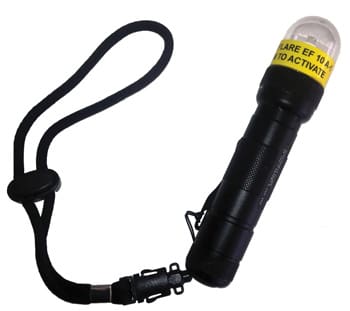Most thinking about emergency situations tend to focus on notifying search and rescue officials via radio or EPIRB (the Coast Guard calls this the notification phase). That makes sense, as notifying SAR units that you are in distress is the first step to getting rescued. But what about the last mile of search and rescue (the Coast Guard calls this the locate phase)? And what about situations when help is nearby and you can’t signal them via radio or distress beacon?
Mariners typically use a visual distress signal device (VDSD). The traditional VDSD were pyrotechnic flares. But there are light-based signaling devices that can be used instead of pyrotechnics. These use lasers, LEDs and incandescent bulbs. The Greatland Green Rescue Laser Flare, the North American Survival Systems EF-10A-1 Electronic LED Flare and the ACR Firefly Pro are all examples of electronic light signaling devices.
In a Coast Guard 2012 study on alternatives to pyrotechnics, burning flares, while the long-time standard in short-distance signaling, have some negatives. “Flares have drawbacks, however; they can injure the user, cause fire on a vessel, and they present significant storage and disposal problems.”
The prime advantage of lasers and LEDs is their light output and greater range compared to older technology Xenon flashtubes and incandescent lights. As the Coast Guard VDSD report notes, “Among the signals tested, LED devices consistently outperformed devices using flashtube or incandescent technology. This is due to the higher effective intensities presented by the LED devices…”
Though not an LED-based device, a good example of a new VDSD is the Greatland Laser GLF032-01 Green Rescue Laser Flare. This hand-held unit can signal for help with the bright light of a green laser. Unlike a laser pointer that projects a dot of light, the Laser Flare has an astigmatizer lens that flattens the laser beam into a line. The line makes aiming the laser easier and increases the chance that it will be seen. According to Greatland Laser, the light can be seen as far away as 30 miles at night and three to five miles in daylight. This laser VDSD won the 2013 Ocean Navigator Chuck Husick Marine Technology Award.
Solid-state LED lamps have advantages over Xenon flashtube-based strobe lights. LED lamps use less power than strobes and can cycle faster. This means faster flashes and longer battery life. According to Coast Guard tests, the faster flash rate of an LED rescue light makes it easier for SAR searchers to locate a crewmember in the water, for instance. Slow-flashing strobes are generally more difficult to home in on.
The North American Survival Systems EF-10A-1 has been tested by the Coast Guard and came out top-ranked in a series of tests conducted in 2012 by the USCG R&D Center (Suitability of Potential Alternatives to Pyrotechnic Distress Signals CG-D-06-12). The Coast Guard established that the bright LEDs of the EF-10A1 had a visual range of five nautical miles, while U.S. Navy tests showed visual range to be as good as seven nm.
Another example of a LED-based device is the ACR Artex Firefly series. The Firefly Pro SOLAS model, for example, has a visible range out to three and a half miles and can flash continuously for more than 56 hours, 48 hours longer than USCG and SOLAS requirement.
Final Coast Guard standards for non-pyrotechnic flares (VDSDs) will be finalized by August 2014.

